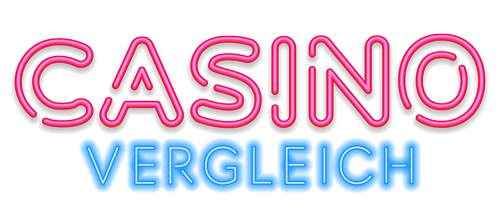Online Casino Vergleich: Die Top Anbieter im Test 2025
- 100% bis zu 500 €
- Cashback von 5 %
- VIP-Programm mit fünf Leveln
- Riesige Spielauswahl mit über 9.000 Titeln
- 100 % Bonus bis zu 500 € plus 200 Freispiele
- Vielfältige und moderne Zahlungsmethoden
- 15 % Cashback bis zu 3.000 €
- Preispools bis zu 2.000.000 €
- 100 % bis zu 500€ Bonus
- Mehr als 5000+ beliebte Spiele
- 100% bis zu 500€ + 200 Freispiele
- 10€ Minimale Einzahlung
- Kryptowährungen werden supported
- Jackpots und Live Casino
- Auszahlungsdauer: 72 Std.
- 1000€ Willkommenspaket + 150 FS
- Über 6.000 Slots
- Sportwetten im Angebot
- 10% Cashback
- 200% Bonus bis zu 7500 €
- Einzahlungen in Krypto oder Euro
- Schnelle Auszahlungen
- Einfaches und benutzerfreundliches Design
- Große Anbieter im Spielangebot
- Zahlungsmethoden mit Bitcoin Unterstützung
- Über 8000 Spiele
- Zahlreiche Boni und Werbeaktionen
- 100%bis zu €500 Bonus
- Faires Wetten
- Spielportfolio umfangreich und hochwertig
- Schicke und moderne Casino-Webseite
- Ein- und Auszahlungen in Euro oder Krypto-Geld
- 100% bis zu 200€ Bonus + 200 Freispiele auf die 1. Einzahlung
- Bis zu 1000€ im Willkommenspaket von 4 Einzahlungen
- Bonus-Codes: SPORTO1 - SPORTO4
- Kryptos werden akzeptiert
- 1000€ Bonus Paket
- Mindesteinzahlung: 20€
- 100% bis zu €1500 Bonus
- Cashback & Exclusive Bonuses
- VIP Club
- Schnelle Auszahlungen
- 500Euro Bonuspaket
- Kryptozahlungen akzeptiert
- Über 5.000 Games von 35 Providern
- Gesonderter Neukundenbonus für Highroller
- Starke Aktionen für Stammspieler
- 100% bis zu 500€ + 200 Freispiele
- 10% bis 500€ Cashback Garantie
- Innovative App
- Top-Spieleangebot in allen Sektionen
- Kooperationen mit über 90 Software-Firmen (inklusive Live)
- Attraktive und faire Aktionen + VIP Programm
pegionline.eu – einen umfassenden Casino Vergleich
Dieser Artikel dient als neutraler und tiefgehender Leitfaden, der einen umfassenden Casino Vergleich ermöglicht. Anstatt konkrete Marken zu benennen und zu bewerten, wird hier ein analytischer Rahmen geschaffen. Dieser befähigt Spieler, Online Casinos eigenständig zu vergleichen und die besten Online Casinos für ihre individuellen Bedürfnisse und ihre persönliche Risikobereitschaft zu identifizieren. Der Fokus liegt auf der Vermittlung von fundiertem Wissen und objektiven Bewertungskriterien, um eine informierte Entscheidung zu ermöglichen.
Der Leitfaden gliedert sich in vier Hauptteile. Zunächst werden die rechtlichen Grundlagen des deutschen Glücksspielmarktes beleuchtet, die das Fundament für jeden Vergleich bilden. Anschließend werden detaillierte Kriterien für einen objektiven Casino Vergleich vorgestellt – von der Lizenzierung und Sicherheit über das Spielangebot und die Bonusbedingungen bis hin zum Zahlungsverkehr. Der dritte Teil widmet sich Strategien für den mündigen Spieler, die ein sicheres und verantwortungsvolles Spielerlebnis fördern. Abschließend wirft der Artikel einen Blick auf die Zukunft des Marktes und technologische Trends, die das Online-Glücksspiel in den kommenden Jahren prägen werden.
Das perfekte Online-Casino bietet eine Kombination aus Unterhaltung und Benutzerfreundlichkeit. Angebotene Boni, wie Willkommensboni, sollten dabei genauestens betrachtet werden, um die Attraktivität für neue Spieler zu beurteilen. Zudem ist das Thema Sicherheit und Lizenzierung ein entscheidender Aspekt, der darüber entscheidet, ob ein Casino als vertrauenswürdig eingestuft werden kann. Ein Casino ohne Lizenz ist nicht automatisch schlecht. Sie müssen entscheiden ob Sie wirklich wollen, dass jemand Ihre Daten verwaltet. Eine Alternative bieten Casinos ohne LUGAS.
Der ultimative Casino Vergleich – Objektive Kriterien für die Auswahl der besten Anbieter
Die Wahl des richtigen Online Casinos hängt von einer Vielzahl von Faktoren ab, die über das reine Spielangebot hinausgehen. Ein zentrales, oft unbewusstes Kriterium ist dabei das zugrundeliegende Vertrauensmodell. Spieler müssen darauf vertrauen können, dass die Spiele fair sind und Gewinne zuverlässig ausgezahlt werden. Dieses Vertrauen wird durch unterschiedliche technologische und regulatorische Ansätze hergestellt, die ein Spektrum von Kontrollmechanismen bilden.
Am einen Ende dieses Spektrums steht das regulatorische Vertrauen, wie es von der GGL in Deutschland etabliert wurde. Hier vertraut der Spieler auf die strikte Aufsicht und die rigiden Regeln einer staatlichen Behörde. In der Mitte befindet sich das Audit-Vertrauen, das typischerweise von der Malta Gaming Authority (MGA) repräsentiert wird. Spieler vertrauen hier auf eine anerkannte Regulierungsbehörde, die ihrerseits unabhängige und renommierte Prüflabore wie eCOGRA oder iTech Labs beauftragt, die Zufälligkeit und Fairness der Spiele zu zertifizieren. Am anderen Ende des Spektrums, oft bei Anbietern mit Lizenzen aus Curaçao und insbesondere bei Krypto-Casinos, findet sich das mathematische Vertrauen. Dieses basiert auf der „Provably Fair“ (PF) Technologie, die es dem Spieler ermöglicht, die Fairness jeder einzelnen Spielrunde durch kryptografische Verfahren selbst zu verifizieren, ohne einer dritten Instanz vertrauen zu müssen.
Die Wahl eines Casinos ist somit auch immer eine Wahl für ein bestimmtes Vertrauensmodell, das zur persönlichen Risikobereitschaft und zum technischen Verständnis des Spielers passen sollte.
Lizenzierung und Sicherheit: Das Fundament des Vertrauens
Die Glücksspiellizenz ist das wichtigste Kriterium für die Seriosität und Sicherheit eines Online-Casinos. Sie gibt Auskunft darüber, von welcher Behörde der Anbieter reguliert wird und welchen Standards er unterliegt.
- Der deutsche Standard (GGL): Eine Lizenz der Gemeinsamen Glücksspielbehörde der Länder bietet deutschen Spielern das höchste Maß an rechtlicher Sicherheit und garantiert die Einhaltung der strengen deutschen Spielerschutzgesetze, einschließlich der Anbindung an OASIS und LUGAS. Der Nachteil sind die bereits beschriebenen, erheblichen Einschränkungen im Spielangebot und bei den Limits.
- Die europäische Alternative (MGA – Malta Gaming Authority): Die Lizenz der MGA gilt weithin als der „Goldstandard“ innerhalb der Europäischen Union. Anbieter mit MGA-Lizenz müssen strenge Auflagen erfüllen, die den Spielerschutz, die Prävention von Geldwäsche (AML), die Fairness der Spiele und die sichere, getrennte Aufbewahrung von Spieler- und Firmengeldern betreffen. Die MGA bietet einen klar strukturierten und für Spieler zugänglichen Beschwerdeprozess, falls es zu Streitigkeiten mit einem Anbieter kommt. Als Behörde eines EU-Mitgliedstaates unterliegen MGA-lizenzierte Casinos zudem der Datenschutz-Grundverordnung (DSGVO), was einen hohen Schutz persönlicher Daten gewährleistet.
- Die globale Option (Curaçao eGaming): Eine Lizenz aus Curaçao ist vor allem für ihre Flexibilität bekannt. Anbieter können sie schneller und kostengünstiger erhalten, was zu einer größeren Vielfalt an neuen und innovativen Casinos führt. Ein wesentlicher Vorteil für Spieler ist die Offenheit dieser Lizenz für Kryptowährungen als Zahlungsmittel. Objektiv betrachtet, galt die regulatorische Aufsicht in der Vergangenheit als weniger streng im Vergleich zur MGA. Spielerschutzmechanismen und die Unterstützung bei Streitfällen waren oft schwächer ausgeprägt. In jüngerer Zeit hat Curaçao jedoch mit dem „LOK-Framework“ (Landsverordening op de Kansspelen) eine umfassende Reform seines Lizenzsystems eingeleitet, um die Aufsicht zu verschärfen und sich internationalen Standards anzunähern.
Die folgende Tabelle stellt die wesentlichen Unterschiede der Lizenzierungsmodelle aus Spielersicht gegenüber, um eine fundierte Entscheidungsgrundlage für den Casino Vergleich zu bieten.
Die Realität in deutschen Online-Casinos (GGL-Lizenz): Regeln und Restriktionen im Detail
Online-Casinos, die über eine offizielle Lizenz der GGL verfügen, bieten Spielern aus Deutschland die höchste rechtliche Sicherheit. Diese Sicherheit geht jedoch mit einer Reihe von signifikanten Einschränkungen einher, die das Spielerlebnis maßgeblich beeinflussen.
- Die 5-Sekunden-Regel: Eine der spürbarsten Regelungen ist die sogenannte 5-Sekunden-Regel, die in § 22a Abs. 6 GlüStV 2021 verankert ist. Diese besagt, dass eine einzelne Spielrunde an einem virtuellen Spielautomaten im Durchschnitt mindestens fünf Sekunden dauern muss. In der Praxis bedeutet dies, dass nach jeder Drehung eine Zwangspause eingelegt wird. Funktionen wie „Autoplay“ (automatisches Drehen) oder „Fastspin/Turbospin“ (schnelles Drehen) sind vollständig verboten. Der offizielle Zweck dieser Maßnahme ist die Verlangsamung des Spiels, um impulsives und potenziell problematisches Spielverhalten zu unterbinden.
- Einsatz- und Einzahlungslimits: Der GlüStV 2021 schreibt strikte finanzielle Grenzen vor. Der Maximaleinsatz an Online-Spielautomaten ist auf 1 € pro Spin begrenzt (§ 22a Abs. 7 GlüStV 2021). Weitreichender ist das anbieterübergreifende monatliche Einzahlungslimit von 1.000 € pro Spieler (§ 6c Abs. 1 GlüStV 2021). Dieses Limit gilt für alle Einzahlungen bei allen in Deutschland lizenzierten Anbietern zusammengerechnet. Zwar besteht die Möglichkeit, dieses Limit auf bis zu 10.000 € oder in Ausnahmefällen sogar 30.000 € zu erhöhen, dies erfordert jedoch eine explizite Beantragung und eine umfassende Bonitätsprüfung, oft unter Einbeziehung von Auskunfteien wie der SCHUFA.
- Die Überwachungssysteme LUGAS und OASIS: Um die Einhaltung dieser Limits zu gewährleisten, wurden zwei zentrale Datenbanken eingeführt.
- LUGAS (Länderübergreifendes Glücksspielaufsichtssystem): Dieses System dient als zentrale Aktivitäts- und Limitdatei. Es überwacht in Echtzeit die anbieterübergreifenden Einzahlungen eines jeden Spielers, um sicherzustellen, dass das monatliche Limit nicht überschritten wird. Zudem verhindert LUGAS, dass sich ein Spieler gleichzeitig bei mehreren Online-Casinos anmeldet und parallel spielt.
- OASIS (Onlineabfrage Spielerstatus): Dies ist das bundesweite Spielersperrsystem, das dem Schutz spielsuchtgefährdeter Personen dient. Spieler können eine Selbstsperre beantragen, die für mindestens drei Monate gilt. Zudem können Dritte (z.B. Familienangehörige oder die Casinobetreiber selbst) eine Fremdsperre veranlassen, wenn Anzeichen für problematisches Spielverhalten vorliegen. Diese gilt für mindestens ein Jahr. Eine Aufhebung der Sperre erfolgt nicht automatisch, sondern muss nach Ablauf der Mindestfrist schriftlich beantragt werden. Anbieter mit deutscher Lizenz sind verpflichtet, vor jedem Login den Status eines Spielers bei OASIS abzufragen.
- Eingeschränktes Spielangebot: Das Spielangebot in GGL-lizenzierten Casinos ist stark reglementiert. Erlaubt sind in erster Linie „virtuelle Automatenspiele“. Klassische Tischspiele wie Roulette und Blackjack, das gesamte Live-Casino-Angebot mit echten Dealern sowie Spielautomaten mit progressiven Jackpots sind grundsätzlich verboten. Für diese Spielformen können die Bundesländer zwar separate Lizenzen vergeben, doch davon wurde bisher kaum Gebrauch gemacht.
Die Alternative: Sicher spielen in Casinos ohne deutsche Lizenz?
Aufgrund der strengen Restriktionen des deutschen Marktes suchen viele Spieler aktiv nach Alternativen. Diese finden sie bei Anbietern, die mit Lizenzen aus anderen EU-Ländern wie Malta oder aus Überseegebieten wie Curaçao operieren.
- Analyse der Rechtslage: Für deutsche Spieler entsteht hier eine komplexe rechtliche Grauzone. Nach deutschem Recht dürfen diese Anbieter hierzulande keine gezielte Werbung schalten und ihre Angebote nicht aktiv an deutsche Kunden richten. Die Teilnahme von Spielern aus Deutschland wird von den meisten dieser Casinos jedoch geduldet. Dies bewegt sich im Spannungsfeld zwischen der deutschen Gesetzgebung und dem Grundsatz der Dienstleistungsfreiheit innerhalb der Europäischen Union. Eine Strafverfolgung von Spielern ist in der Praxis äußerst selten, dennoch besteht keine vollständige Rechtssicherheit.
- Die Attraktivität der „unregulierten“ Anbieter: Die Gründe für die Beliebtheit dieser Casinos liegen auf der Hand – sie bieten genau das, was in Deutschland lizenzierten Anbietern verwehrt ist. Spieler können hier ohne die 5-Sekunden-Regel spielen, es gibt keine pauschalen Einsatz- oder Einzahlungslimits, und das Spielangebot ist ungleich größer. Es umfasst klassische Tischspiele, ein umfangreiches Live-Casino-Portfolio und die beliebten progressiven Jackpot-Slots. Zudem sind die Bonusangebote oft höher und vielfältiger, und es werden modernere Zahlungsmethoden, einschließlich Kryptowährungen, akzeptiert.
- Das erhöhte Risiko und die Eigenverantwortung: Die größere spielerische Freiheit geht unweigerlich mit einer höheren Eigenverantwortung einher. Die zentralen deutschen Schutzmechanismen wie die Sperrdatei OASIS und das Überwachungssystem LUGAS greifen hier nicht. Spieler müssen ihre Limits selbstständig verwalten und ihr Spielverhalten eigenverantwortlich kontrollieren. Zudem kann die rechtliche Durchsetzung von Ansprüchen, beispielsweise bei Auszahlungsstreitigkeiten, komplizierter sein, da sie unter der Gerichtsbarkeit eines anderen Landes stattfindet.
Echtgeld Casinos: So wird im Online Casino ein- und ausgezahlt
Die Einzahlungsmethoden in den Online Casinos
Die führenden Online Casinos bieten eine Vielzahl von Einzahlungsmethoden an, um sicherzustellen, dass jeder Spieler den für sich passenden Weg findet. In Deutschland nutzten viele Spieler früher PayPal, doch seit Oktober 2019 ist der Dienst nicht mehr für Glücksspiel verfügbar. Stattdessen stehen nun andere eWallets wie Skrill und Neteller im Vordergrund. Auch Dienste wie EcoPayz, Qiwi und Webmoney werden häufig angeboten.
Kreditkarten sind eine weitere verbreitete Methode. Die MasterCard und ihre verbundenen Debitkarten sind fast überall akzeptiert. Visa wurde vielerorts aus dem Angebot genommen. Für kleinere Beträge sind Prepaid-Methoden wie die Paysafecard, CashToCode und Cashlib beliebt. Für schnelle Banküberweisungen gibt es Klarna Sofort, Trustly, Rapid und GiroPay.
Mobile Zahlungslösungen gewinnen ebenfalls an Bedeutung. Apple Pay und MuchBetter führen die Liste der Handybezahlmethoden an.
Neu: Bitcoin und andere Kryptowährungen
Viele Online Casinos haben begonnen, Bitcoin und andere Kryptowährungen als Zahlungsmittel zu akzeptieren. Spieler können mit Bitcoin, Litecoin, Ethereum oder Dogecoin Einzahlungen tätigen. Diese Beträge werden oft vor dem Spielen in Euro oder eine andere Hauptwährung umgewandelt. Es gibt sogar Casinos, die sich als reine Bitcoin-Casinos definieren, wo alle Transaktionen direkt in Kryptowährung abgewickelt werden.
Ein wichtiger Punkt: Gewinne aus Bitcoin-Einzahlungen werden immer auf das ursprüngliche BTC Wallet zurücküberwiesen. Eine Umwandlung in andere Währungen innerhalb des Casinos ist nicht möglich.
Auszahlung: So solltest du deine Gewinne erhalten
Die Auszahlung der Gewinne ist für viele Spieler ein entscheidender Punkt. Die besten Casinos arbeiten mit teilautomatischen Systemen, die sicherstellen, dass Auszahlungen schnell erfolgen. Manche Anbieter bearbeiten Anträge innerhalb weniger Stunden, was bedeutet, dass Spieler ihre Gewinne oft noch am selben Tag erhalten. Einige Plattformen haben jedoch feste Bearbeitungszeiten von bis zu drei oder vier Tagen.
Ein weiterer wichtiger Aspekt ist der geschlossene Geldkreislauf. Auszahlungen erfolgen über denselben Weg, über den auch eingezahlt wurde, sofern dies technisch möglich ist. Falls dies nicht geht, steht immer die klassische Banküberweisung zur Verfügung. Manche Casinos zahlen Gewinne bis zur Höhe des Einzahlungsbetrages über denselben Weg zurück, was zu mehreren Teilauszahlungen führen kann, wenn mehrere Einzahlungsmethoden genutzt wurden.
Die Limits bei den Casino Ein- und Auszahlungen
Die Limits bei Ein- und Auszahlungen variieren je nach Casino. Die Mindesteinzahlungen liegen meist bei 10 oder 20 Euro. Die maximalen Einzahlungsbeträge hängen von der gewählten Methode ab, wobei pauschale Obergrenzen von 4.000 oder 5.000 Euro nicht unüblich sind.
Die Auszahlungslimits sind besonders bei großen Gewinnen relevant. Neuere Casinos sind oft vorsichtiger, während etablierte Anbieter höhere Beträge zulassen. Die AGB der Casinos geben meist klare Transaktionslimits pro Tag, Woche oder Monat an. Es ist üblich, dass hohe Gewinne in Raten ausgezahlt werden, wobei progressive Jackpot-Gewinne eine Ausnahme darstellen und in voller Höhe ausgezahlt werden.
Vor der ersten Abhebung: Seriöser Check sicherer Online Casinos
Seriöse Online Casinos zahlen Gewinne nicht ohne eine Überprüfung der Identität ihrer Spieler aus. Vor der ersten Auszahlung müssen die sogenannten KYC-Dokumente (Know Your Customer) eingereicht werden. Diese bestehen aus einem Lichtbildausweis (Personalausweis, Reisepass oder Führerschein) und einer Adressbestätigung (beispielsweise durch eine Rechnung eines Versorgungsunternehmens).
Dieser Schritt stellt sicher, dass die Gewinne an die rechtmäßigen Personen ausgezahlt werden und hilft, Betrug zu verhindern. Spieler, die falsche Daten bei der Registrierung angegeben haben, könnten bei der ersten Auszahlung auf Probleme stoßen.
Bonusangebote und Promotionen: Wie man faire Angebote erkennt
Bonusangebote sind ein zentrales Marketinginstrument von Online Casinos, um neue Kunden zu gewinnen und bestehende Spieler zu binden. Für Spieler können sie eine wertvolle Möglichkeit sein, das eigene Startkapital zu erhöhen und neue Spiele auszuprobieren. Der wahre Wert eines Bonus bemisst sich jedoch nicht an seiner Höhe, sondern an der Fairness der damit verbundenen Bedingungen.
- Typologie der Boni: Die gängigsten Bonusarten, denen Spieler begegnen, sind:
- Willkommensbonus (Einzahlungsbonus): Dies ist das häufigste Angebot für Neukunden. Dabei wird die erste (oder die ersten mehrere) Einzahlung(en) um einen bestimmten Prozentsatz (z.B. 100%) bis zu einem Maximalbetrag aufgestockt.
- Bonus ohne Einzahlung (No-Deposit Bonus): Hierbei erhalten Spieler ein kleines Startguthaben oder einige Freispiele nur für die Registrierung, ohne selbst Geld einzahlen zu müssen. Diese Boni sind seltener und unterliegen meist sehr strengen Bedingungen.
- Freispiele (Free Spins): Spieler erhalten eine bestimmte Anzahl an kostenlosen Drehungen für einen oder mehrere ausgewählte Spielautomaten. Gewinne aus diesen Freispielen werden in der Regel als Bonusguthaben gutgeschrieben.
- Cashback-Angebote: Bei dieser Promotion erhalten Spieler einen prozentualen Anteil ihrer Nettoverluste über einen bestimmten Zeitraum (z.B. eine Woche) als Bonusguthaben zurück. Cashback ist oft Teil von VIP- oder Treueprogrammen.
- Das Kleingedruckte entschlüsseln – Ein Leitfaden zu den Bonusbedingungen: Der entscheidende Teil eines jeden Bonusangebots sind die AGBs. Ein gründlicher Casino Vergleich muss diese Bedingungen analysieren:
- Umsatzbedingungen (Wagering Requirements): Dies ist die wichtigste Regel. Sie gibt an, wie oft ein Bonusbetrag (und manchmal auch der eingezahlte Betrag) im Casino umgesetzt, also als Einsatz platziert werden muss, bevor das Bonusguthaben und daraus erzielte Gewinne in auszahlbares Echtgeld umgewandelt werden. Ein Branchenstandard liegt bei einem 35- bis 40-fachen Umsatz des Bonusbetrags.
- Gültigkeitsdauer: Jeder Bonus hat ein Ablaufdatum. Spieler haben nur einen begrenzten Zeitraum (oft 7 bis 30 Tage), um die Umsatzbedingungen zu erfüllen. Wird dies nicht geschafft, verfallen der Bonus und alle damit erzielten Gewinne.
- Maximaler Einsatz (Max Bet): Solange ein Bonus aktiv ist, darf der Einsatz pro Spielrunde einen bestimmten Betrag (üblicherweise 5 €) nicht überschreiten. Ein Verstoß gegen diese Regel führt fast immer zur Annullierung des Bonus.
- Spielbeiträge (Game Contributions): Nicht alle Spiele tragen gleichermaßen zur Erfüllung der Umsatzbedingungen bei. Während Einsätze an Spielautomaten meist zu 100% gewertet werden, zählen Tischspiele wie Blackjack oder Roulette oft nur zu 10% oder gar nicht. Live-Casino-Spiele sind häufig komplett ausgeschlossen.
- Gewinnlimit (Win Cap): Insbesondere bei Boni ohne Einzahlung und Freispielen gibt es oft eine Obergrenze für den maximal auszahlbaren Gewinn (z.B. 100 €). Selbst wenn man mehr gewinnt, wird der überschüssige Betrag storniert.
Die folgende Tabelle fasst die gängigsten Bonusarten und die damit verbundenen Fallstricke zusammen, um Spielern ein schnelles Nachschlagewerk für die Bewertung von Promotionen zu bieten.
Spielangebot und Software: Qualität, Vielfalt und Fairness
Die Qualität eines Online Casinos steht und fällt mit seinem Spielangebot. Dabei sind nicht nur die schiere Anzahl der Spiele, sondern vor allem deren Qualität, Vielfalt und nachweisliche Fairness entscheidend.
- Die Rolle der Software-Provider: Ein entscheidendes Qualitätsmerkmal ist die Zusammenarbeit mit renommierten Software-Entwicklern. Namen wie NetEnt, Play’n GO, Pragmatic Play, Microgaming oder Evolution Gaming sind nicht nur für ihre innovativen und unterhaltsamen Spiele bekannt, sondern auch für ihre Seriosität. Diese Unternehmen sind selbst in mehreren Jurisdiktionen lizenziert und lassen ihre Spiele regelmäßig von unabhängigen Institutionen auf Fairness und korrekte Funktionsweise der Zufallszahlengeneratoren überprüfen. Ein Casino, das Spiele dieser Top-Provider anbietet, signalisiert damit, dass es sich an hohe Qualitäts- und Fairness-Standards hält.
- Analyse der Spielkategorien: Ein gutes Online Casino bietet eine breite Palette an Spielarten, um unterschiedliche Vorlieben zu bedienen.
- Spielautomaten (Slots): Sie bilden das Herzstück der meisten Online-Casinos. Für einen fundierten Vergleich sollten Spieler auf folgende Merkmale achten: Die Auszahlungsquote (RTP – Return to Player) gibt an, welcher Prozentsatz der Einsätze langfristig theoretisch wieder an die Spieler ausgeschüttet wird. Werte über 96% gelten als gut. Die Volatilität (oder Varianz) beschreibt das Risikoprofil eines Slots: niedrige Volatilität bedeutet häufige, aber kleinere Gewinne, während hohe Volatilität seltene, aber potenziell sehr hohe Gewinne verspricht. Zudem sind die verfügbaren Features wie Wild-Symbole (Joker), Scatter-Symbole (lösen oft Boni aus) und Freispiel- oder Bonusrunden entscheidend für den Spielspaß und das Gewinnpotenzial.
- Tischspiele: Hierzu zählen die digitalen Versionen der Casino-Klassiker wie Roulette, Blackjack, Baccarat und diverse Pokervarianten. Gute Anbieter haben mehrere Varianten dieser Spiele im Programm (z.B. europäisches, französisches und amerikanisches Roulette).
- Live-Casino: Dieser Bereich bietet die immersivste Erfahrung, da hier Spiele von echten Dealern geleitet und per HD-Videostream auf den Bildschirm des Spielers übertragen werden. Neben den klassischen Tischspielen erfreuen sich interaktive Game Shows wie „Crazy Time“ oder „Monopoly Live“ großer Beliebtheit, die Elemente von Glücksrädern und Fernsehshows kombinieren.
Garantierte Fairness – RNG vs. Provably Fair: Das Vertrauen der Spieler basiert auf der Gewissheit, dass die Spielergebnisse nicht manipuliert sind. Dafür gibt es zwei technologische Ansätze.
-
- RNG (Random Number Generator): Dies ist der etablierte Standard. Ein komplexer Algorithmus, der Zufallszahlengenerator, erzeugt pro Millisekunde Tausende von Zufallszahlen. Das Ergebnis eines Spins oder einer Kartenverteilung ist das Resultat dieser Zufallszahl in genau dem Moment, in dem der Spieler den Button klickt. Seriöse Casinos lassen ihre RNGs von unabhängigen, international anerkannten Prüflaboren wie eCOGRA oder iTech Labs zertifizieren. Diese Zertifikate bestätigen, dass die Ergebnisse tatsächlich zufällig und nicht vorhersagbar oder manipulierbar sind.
- Provably Fair (PF): Diese neuere Technologie, die vor allem in Krypto-Casinos zum Einsatz kommt, basiert auf kryptografischen Prinzipien. Vereinfacht ausgedrückt, erzeugt der Server des Casinos vor der Spielrunde einen geheimen Wert (Server Seed) und zeigt dem Spieler dessen verschlüsselte Version (Hash). Der Spieler liefert ebenfalls einen Wert (Client Seed). Aus der Kombination beider Seeds und einer fortlaufenden Nummer (Nonce) wird das Ergebnis berechnet. Nach der Runde legt der Server seinen ursprünglichen Seed offen. Der Spieler kann nun mit frei verfügbaren Tools nachrechnen, ob der offengelegte Server Seed zum anfangs gezeigten Hash passt und ob die Kombination der Werte tatsächlich zum angezeigten Spielergebnis führt. Dies ermöglicht eine mathematische Verifikation der Fairness jeder einzelnen Runde, ohne auf das Vertrauen in eine dritte Prüfinstanz angewiesen zu sein.
Top 10 Spiele 2025:
- Book of Dead (Play’n Go)
- Starburst (NetEnt)
- Legacy of Dead (Play’n Go)
- Wolf Gold (Pragmatic Play)
- Gonzos Quest (NetEnt)
- Bonanza Megaways (Big Time Gaming)
- Gonzos Quest Megaways (Red Tiger)
- Fire Joker (Play’n Go)
- Reactoonz 2 (Play’n Go)
- Ramses Book (Gamomat)
Neben normalen Slots gibt es auch progressive Jackpots, die Millionenbeträge bieten. Herausragende Spiele hier sind Mega Moolah (Microgaming) und Hall of Gods (NetEnt), die mit rekordverdächtigen Auszahlungen locken. Es gibt auch verbundene Jackpots wie Daily-Jackpots von Betsoft und Gamomat.
Die klassischen Casino Spiele: Roulette, Blackjack & Co
Roulette und Blackjack sind unerlässliche Bestandteile jedes Casinos. Diese Klassiker finden sich in vielfältiger Weise in den Spielportfolios der Online-Casinos. Variationen wie Französisches und Amerikanisches Roulette sowie Blackjack in unterschiedlichen Ausführungen bieten Abwechslung.
Live Casinos: Tischspiele im Stream
Live-Dealer-Spiele bieten ein authentisches Casino-Erlebnis, ohne dass man das Haus verlassen muss. Nutzer können per Stream mit echten Dealern interagieren und Spiele wie Roulette, Blackjack und Baccarat in Echtzeit erleben. Die Atmosphäre eines Live-Casinos wird durch hochwertige Videoübertragungen und interaktive Funktionen verstärkt.
Video Poker Automaten: Gaming auf hohem Niveau
Video Poker kombiniert Poker-Elemente mit Slotmaschinenspiel. Varianten wie Jacks or Better und Deuces Wild ermöglichen es Spielern, strategisch vorzugehen und ihre Gewinnchancen zu verbessern. Diese Spiele bieten eine Mischung aus Glück und Geschicklichkeit und erfreuen sich großer Beliebtheit.
Arcade Spiele: Die lockere Unterhaltung
Arcade-Games in Online-Casinos bieten eine leichtere Unterhaltung. Diese Spiele sind oft von klassischen Automaten inspiriert und bieten schnelle, unkomplizierte Spielmechaniken. Beispiele hierfür sind Geschicklichkeits- und Geschicklichkeitsspiele, die den Spielern eine entspannte Abwechslung vom intensiveren Casino-Gameplay bieten.
Rubbellose: Der schnelle Weg zum Gewinn
Rubbellose bieten eine sofortige Gewinnaussicht. Spieler können virtuelle Karten freikratzen und sofort sehen, ob sie gewonnen haben. Diese Spiele sind einfach und schnell zu spielen, was sie besonders für Gelegenheitsnutzer attraktiv macht.
Virtuelle Sport Spiele: In der Szene immer beliebter
Virtuelle Sportspiele simulieren verschiedene Sportarten und ermöglichen es den Spielern, auf die Ergebnisse dieser Simulationen zu wetten. Fußball, Pferderennen und andere Sportarten sind in diesen Spielen vertreten. Die Kombination aus Sportwetten und schneller Spielmechanik macht diese Kategorie besonders spannend für viele Nutzer.
Zahlungsverkehr: Schnelligkeit, Sicherheit und Flexibilität
Ein reibungsloser, sicherer und schneller Zahlungsverkehr ist ein Eckpfeiler eines vertrauenswürdigen Online Casinos. Spieler müssen darauf vertrauen können, dass ihre Einzahlungen sofort verfügbar sind und Gewinne zuverlässig und zügig ausgezahlt werden.
- Überblick über gängige Zahlungsmethoden:
- Kredit- und Debitkarten (Visa, Mastercard): Weit verbreitet und einfach zu nutzen, aber der Spieler teilt seine Kartendaten direkt mit dem Casino.
- E-Wallets (Skrill, Neteller, MiFinity, etc.): Bieten eine hohe Sicherheit, da sie als Vermittler fungieren und die eigentlichen Bank- oder Kreditkartendaten nicht an das Casino weitergegeben werden. Transaktionen sind in der Regel sehr schnell.
- Prepaid-Optionen (Paysafecard, CashtoCode): Ermöglichen anonyme Einzahlungen, da sie mit Bargeld im Einzelhandel erworben werden können. Auszahlungen sind auf diesem Weg jedoch meist nicht möglich.
- Kryptowährungen (Bitcoin, Ethereum, Litecoin, etc.): Bieten ein hohes Maß an Anonymität und Sicherheit durch die Blockchain-Technologie. Transaktionen sind oft die schnellsten verfügbaren, sowohl bei Ein- als auch bei Auszahlungen. Sie sind hauptsächlich in Casinos mit Curaçao-Lizenz zu finden.
- Analyse von Limits und Bearbeitungszeiten: Ein wichtiger Punkt im Casino Vergleich sind die finanziellen Rahmenbedingungen. Dazu gehören die Mindestbeträge für Ein- und Auszahlungen (sollten spielerfreundlich niedrig sein, z.B. 10-20 €) und die maximalen Auszahlungslimits (täglich, wöchentlich, monatlich). Hohe Auszahlungslimits sind ein Zeichen für die finanzielle Stabilität eines Anbieters. Die Bearbeitungszeit für Auszahlungen ist ebenfalls kritisch. Während E-Wallets und Kryptowährungen oft Auszahlungen innerhalb von Stunden ermöglichen, können Banküberweisungen mehrere Werktage dauern.
- Der KYC-Prozess (Know Your Customer): Dieser Prozess ist keine Schikane der Casinos, sondern eine gesetzliche Anforderung, die der Prävention von Geldwäsche (AML – Anti-Money Laundering) und dem Jugendschutz dient. Vor der ersten Auszahlung muss jeder Spieler seine Identität verifizieren. Typischerweise werden dafür folgende Dokumente angefordert:
- Ein gültiges Ausweisdokument (Personalausweis, Reisepass).
- Ein Adressnachweis (z.B. eine aktuelle Strom- oder Telefonrechnung).
- Teilweise ein Nachweis über die verwendete Zahlungsmethode (z.B. ein Screenshot des E-Wallet-Kontos). Einige Anbieter, insbesondere solche mit deutscher Lizenz, fordern diese Verifizierung bereits bei der Registrierung (z.B. per Video-Ident-Verfahren), während andere sie erst vor der ersten Auszahlung durchführen.
- Chargebacks (Rückbuchungen): Spieler sollten wissen, dass eine Rückbuchung von Einzahlungen über den Kreditkartenanbieter (z.B. Visa, Mastercard) nur unter bestimmten Umständen möglich ist. Ein legitimer Grund wäre eine nicht autorisierte Transaktion (Betrug) oder ein technischer Fehler (z.B. Doppelbuchung). Verlorene Spieleinsätze sind explizit kein gültiger Grund für einen Chargeback. Ein missbräuchlicher Einsatz dieses Instruments führt in der Regel zur sofortigen und dauerhaften Sperrung des Spielerkontos.
Benutzererfahrung und Kundenservice
Neben den harten Fakten wie Lizenz und Spielangebot sind auch weichere Faktoren entscheidend für ein positives Spielerlebnis. Die technische Umsetzung der Plattform und die Qualität des Supports sind hierbei zentral.
- Mobiles Spielen: App vs. mobile Webseite: In der heutigen Zeit findet ein Großteil des Spielgeschehens auf mobilen Endgeräten statt. Anbieter stellen hierfür zwei Lösungen bereit:
- Native Casino App (zum Download): Der Vorteil liegt oft in einer besseren Performance, optimierter Grafik und der Möglichkeit von Push-Benachrichtigungen für neue Boni. Nachteile sind der benötigte Speicherplatz auf dem Gerät und die Notwendigkeit von regelmäßigen Updates.
- Mobile Webseite (Web-App): Diese ist universell über jeden mobilen Browser (Chrome, Safari etc.) zugänglich, ohne dass eine Installation erforderlich ist. Dies spart Speicherplatz und ist mit allen Betriebssystemen kompatibel. Manchmal kann die Navigation im Vergleich zu einer dedizierten App etwas weniger flüssig sein. Die Entscheidung zwischen beiden Optionen ist oft eine Frage der persönlichen Präferenz, aber ein gutes Online Casino sollte zumindest eine exzellent optimierte mobile Webseite anbieten.
- Kundenservice als Qualitätsmerkmal: Ein exzellenter Kundenservice ist ein oft unterschätztes, aber kritisches Qualitätsmerkmal. Im Problemfall – sei es eine Frage zu Bonusbedingungen, ein technisches Problem oder eine Verzögerung bei der Auszahlung – ist ein schneller und kompetenter Support entscheidend. Ideale Merkmale sind:
- Erreichbarkeit: Ein 24/7-Live-Chat ist der Goldstandard für schnelle Hilfe. Eine E-Mail-Option sollte ebenfalls vorhanden sein.
- Kompetenz: Die Support-Mitarbeiter sollten gut geschult sein und präzise, hilfreiche Antworten geben können.
- Sprache: Für Spieler aus Deutschland ist ein deutschsprachiger Kundenservice ein erheblicher Vorteil, um Missverständnisse zu vermeiden.
Online Casino Tipps & Tricks
Wer in Online Casinos erfolgreich sein möchte, sollte einige wichtige Tipps & Tricks beachten:
- Bestimmung des seriösen Bankrolls: Spieler sollten nur Geld einsetzen, das sie auch bereit sind zu verlieren. So bleibt das Spielen sicher und kontrollierbar.
- Defensive Strategie: Es empfiehlt sich, mit niedrigen Beträgen im Verhältnis zum gesamten Guthaben zu spielen. Diese vorsichtige Herangehensweise minimiert das Risiko großer Verluste.
- Feste Zeiten festlegen: Bevor man mit dem Spielen beginnt, sollte man eine maximale Spielzeit festlegen, um nicht die Kontrolle zu verlieren.
- Auszahlungsquoten beachten: Die sogenannten RTP-Werte (Return to Player) der Spiele sind unterschiedlich. Es ist ratsam, die Spiele mit höheren RTP-Werten zu wählen.
- Spiele im Funmodus testen: Bevor echtes Geld eingesetzt wird, sollte man die Spiele im Funmodus ausprobieren. Dies hilft, die Regeln und die Dynamik der Spiele besser zu verstehen.
- Boni nutzen: Viele Casinos bieten Boni und Aktionen an. Diese können genutzt werden, um das eigene Guthaben risikofrei zu erhöhen.
- Gewinne regelmäßig auszahlen lassen: Es ist sinnvoll, sich erzielte Gewinne regelmäßig auszahlen zu lassen, um sicherzustellen, dass man sie nicht wieder verliert.
Diese Tipps können helfen, die Spielsession erfolgreicher und unterhaltsamer zu gestalten. Weitere Informationen findet man in den Online Casino Tipps & Tricks 2024.
Aber bitte beachte, dass Glücksspiel immer mit Verantwortung betrieben werden sollte. Denn Glücksspiel kann auch zu einer Sucht führen.
Solltest du dich darüber mehr informieren wollen, gibt es bestimmte Informationsseiten hierzu:
https://www.spielsucht-therapie.de
https://www.spielen-mit-verantwortung.de
FAQs – Häufig gestellte Fragen zu den Online Casinos im Vergleich
Ist es notwendig, dass ein Online Casino eine deutsche Lizenz besitzt?
Aktuell ist es nicht zwingend erforderlich, dass ein Online Casino eine deutsche Lizenz besitzt. Zahlreiche Casinos operieren legal mit Lizenzen anderer Länder, wie Malta. Eine solche Lizenzierung von der Malta Gaming Authority bietet Sicherheit und Seriosität.
Welche Informationen sollte ein Casino-Impressum enthalten?
Ein vollständiges Impressum ist ein Zeichen für Seriosität. Es sollte den Firmennamen, die Anschrift, den Eintrag ins Handelsregister sowie die gültige Lizenznummer enthalten. Diese Informationen können dann beispielsweise mit der Datenbank der Malta Gaming Authority abgeglichen werden.
Kann ich die Auszahlungsquoten der Spiele selbst berechnen?
Ja, theoretisch ist es möglich, die Auszahlungsquoten nachzurechnen. Praktisch ist dies jedoch sehr kompliziert und zeitaufwändig. Es empfiehlt sich, diese Aufgabe Prüforganisationen zu überlassen, die langfristige Tests durchführen.
Warum finde ich PayPal nicht mehr im Einzahlungsportfolio?
PayPal operiert nur in regulierten Märkten. In Deutschland basierte der Dienst auf den Lizenzen aus Schleswig-Holstein. Mit deren Wegfall hat PayPal sich temporär zurückgezogen, ist aber in Ländern wie Österreich weiterhin verfügbar.
Erhalte ich die Auszahlung der progressiven Jackpots immer in voller Höhe?
Ja, wer einen progressiven Jackpot gewinnt, erhält den gesamten Betrag auf einmal. Die Auszahlung wird nicht von den Online Casinos, sondern von den Spieleentwicklern abgewickelt.
Wie beliebt sind Bitcoin Ein- und Auszahlungen in Deutschland?
Bitcoin wird in Deutschland zwar akzeptiert, bleibt aber eine Nische. Die Akzeptanz hat zugenommen, aber viele Spieler bevorzugen weiterhin traditionelle Zahlungsmethoden.
Ist es notwendig, dass der Kundenservice rund um die Uhr erreichbar ist?
Nein, ein 24/7 Kundenservice ist eher ein Marketingmittel. Wichtiger ist, dass der Support während der normalen Geschäftszeiten und abends erreichbar ist.
An wen kann ich mich wenden, wenn der Support des Casinos nicht hilft?
Der primäre Ansprechpartner bei Problemen ist der Kundenservice des Casinos. Sollte dieser nicht helfen, kann man sich an die zuständige Aufsichtsbehörde wenden, wie die Malta Gaming Authority.
Bin ich verpflichtet, einen Online Casino Bonus anzunehmen?
Nein, niemand ist verpflichtet, einen Bonus anzunehmen. Es handelt sich um ein freiwilliges Angebot, das man nach den eigenen Spielvorlieben annehmen oder ablehnen kann.
Kann ein No-Deposit Bonus nach Erfüllung der Umsatzbedingungen ausgezahlt werden?
Ja, nach Erfüllung der Umsatzbedingungen ist eine Auszahlung möglich, sofern mindestens eine Einzahlung zuvor getätigt wurde. Direkt kann ein No-Deposit Bonus nicht abgehoben werden.
Kann ich die Spielautomaten für die Free Spins selbst auswählen?
Die Auswahl der Spielautomaten für kostenlose Drehungen wird vom Casino vorgegeben. Auch die Einsatzsummen und die Anzahl der Gewinnlinien sind festgelegt.
Werde ich die Bonusbedingungen immer vollständig erfüllen können?
Nicht immer. Viele Spieler scheitern an den Bonusbedingungen. Wichtig ist, dass die Bedingungen fair und erfüllbar sind, auch wenn der Bonus womöglich nicht komplett umgesetzt wird.
Wie komme ich an den Slots am schnellsten in den Freispielmodus?
Einige moderne Spielautomaten bieten eine Bonus-Kauf-Funktion, mit der man sich die Freispiele direkt erkaufen kann. Dies beschleunigt den Prozess erheblich, erfordert jedoch eine höhere Investition.
Gibt es Regelunterschiede zwischen Online Casinos und stationären Spielbanken?
Nein, die Grundregeln für Spiele wie Blackjack und Roulette sind identisch. Online-Versionen bieten jedoch oft zusätzliche Spielvarianten, die in physischen Casinos nicht verfügbar sind.
Welche Besonderheit ist beim Bonus-Rollover für Slots zu beachten?
Beim Erfüllen der Bonusbedingungen an Slots sollte man die Einsatzlimits und Spielbeiträge beachten. Manche Slots tragen mehr zur Erfüllung der Umsatzbedingungen bei als andere.
Mobile Webseite oder native Casino App – was ist besser?
Beide Optionen haben ihre Vorzüge. Mobile Webseiten sind flexibel und benötigen keinen Speicherplatz, während native Apps oft eine bessere Performance und zusätzliche Funktionen bieten.
Gibt es Online Casinos, in denen ich mich nicht registrieren muss?
Ja, einige Online Casinos bieten ein sogenanntes „Pay N Play“ Modell an, bei dem keine Registrierung notwendig ist. Man spielt einfach mit einer direkten Einzahlung.
























